Digitization help student to explore and study their academic courses online, as this gives them flexibility and scheduling their learning at their convenience. Kidsfront has prepared unique course material of Reasoning Syllogistic Reasoning for Territorial Army Officers Exam student. This free online Reasoning study material for Territorial Army Officers Exam will help students in learning and doing practice on Syllogistic Reasoning topic of Territorial Army Officers Exam Reasoning. The study material on Syllogistic Reasoning , help Territorial Army Officers Exam Reasoning students to learn every aspect of Syllogistic Reasoning and prepare themselves for exams by doing online test exercise for Syllogistic Reasoning , as their study progresses in class. Kidsfront provide unique pattern of learning Reasoning with free online comprehensive study material and loads of Territorial Army Officers Exam Reasoning Syllogistic Reasoning exercise prepared by the highly professionals team. Students can understand Syllogistic Reasoning concept easily and consolidate their learning by doing practice test on Syllogistic Reasoning regularly till they excel in Reasoning Syllogistic Reasoning .
 Below are given statements followed by some conclusions. You have to take the given statements to be
true even if they seem to be at variance with the commonly known facts.
Below are given statements followed by some conclusions. You have to take the given statements to be
true even if they seem to be at variance with the commonly known facts.  Correct Answer Is : Only conclusion II follows
Correct Answer Is : Only conclusion II follows Two statements are given followed by two Conclusions I and II. You have to consider the statement to be true, even if it seems to be at variance from commonly known facts. You to decide which of the given conclusions can definitely be drawn from the given statement. Indicate your answer.
Statements All children are students.
All students are players.
Two statements are given followed by two Conclusions I and II. You have to consider the statement to be true, even if it seems to be at variance from commonly known facts. You to decide which of the given conclusions can definitely be drawn from the given statement. Indicate your answer.
Statements All children are students.
All students are players. Correct Answer Is : Only conclusion II follows
Correct Answer Is : Only conclusion II follows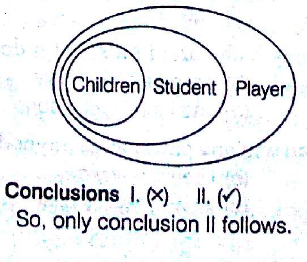
 Statements:
Statements: Correct Answer Is : Only conclusion I follows
Correct Answer Is : Only conclusion I follows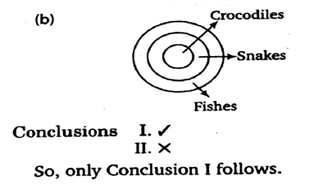
 Statements:
Statements: Correct Answer Is : FALSE
Correct Answer Is : FALSE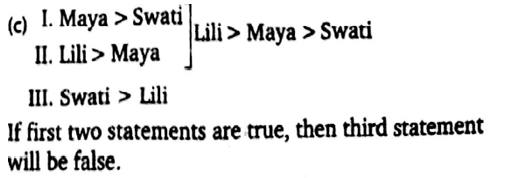
 Two statements are given, followed by two conclusions I and II. You have to consider the statements to be true even if they seem to be at variance from commonly known facts. You have to decide which of the given conclusions, if any, follow from the given statements
Statements
Two statements are given, followed by two conclusions I and II. You have to consider the statements to be true even if they seem to be at variance from commonly known facts. You have to decide which of the given conclusions, if any, follow from the given statements
Statements Correct Answer Is : Both conclusions I and II follow
Correct Answer Is : Both conclusions I and II follow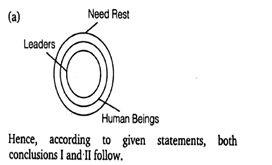
 Q.In this question, a statement is given followed by two conclusions I and II. You have to consider the statement to be true even if it seems to be at variance from commonly known facts. You have to decide which of the given conclusions. If any follows from the given statement.
Statement Tension is detrimental to physical and mental health.
Conclusions
I. To be healthy one should be free from tension.
II. Mental health depends upon the tension one experiences.
Q.In this question, a statement is given followed by two conclusions I and II. You have to consider the statement to be true even if it seems to be at variance from commonly known facts. You have to decide which of the given conclusions. If any follows from the given statement.
Statement Tension is detrimental to physical and mental health.
Conclusions
I. To be healthy one should be free from tension.
II. Mental health depends upon the tension one experiences. Correct Answer Is : Both I and II follow
Correct Answer Is : Both I and II follow In this question, two statements are given followed by four conclusions I ,II, III and IV. You have to consider the two statements to be true even if it seems to be at variance from commonly known facts. You have to decide which of the given conclusions. If any follows from the given statement.
In this question, two statements are given followed by four conclusions I ,II, III and IV. You have to consider the two statements to be true even if it seems to be at variance from commonly known facts. You have to decide which of the given conclusions. If any follows from the given statement. Correct Answer Is : Only II follows
Correct Answer Is : Only II follows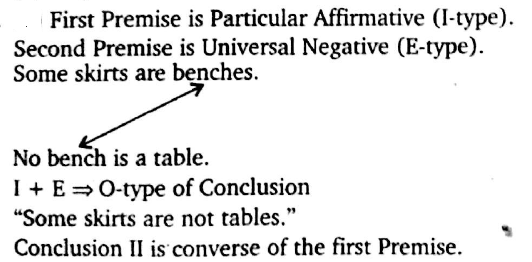
 Two statements are given followed by four alternative inferences. Select the one which is most appropriate.
Two statements are given followed by four alternative inferences. Select the one which is most appropriate. Correct Answer Is : All files are coded
Correct Answer Is : All files are coded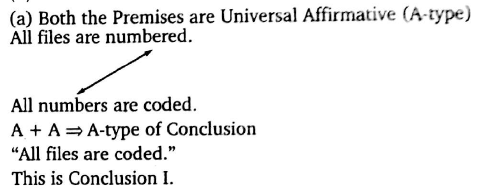
 Two statements are given followed by two inferences I and II. You have to consider the statements to be true even if they seem to be at variance from commonly known facts. You are to decide which of the given inferences can definitely be drawn from the given statements.
Statements:
All cupboards are watches.
All watches are costly.
Inferences:
I . All cup boards are costly.
II. Some costly things are cupboards.
Two statements are given followed by two inferences I and II. You have to consider the statements to be true even if they seem to be at variance from commonly known facts. You are to decide which of the given inferences can definitely be drawn from the given statements.
Statements:
All cupboards are watches.
All watches are costly.
Inferences:
I . All cup boards are costly.
II. Some costly things are cupboards. Correct Answer Is : Both of them follow
Correct Answer Is : Both of them follow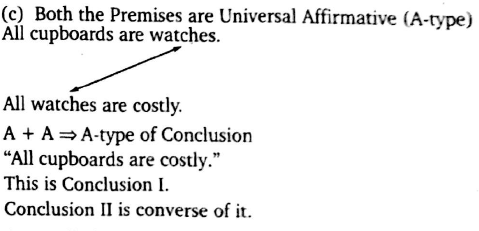
 In the following question, two statements are given followed by two conclusions I and II . You have to consider the statements to be true even if they seem to be at variance from commonly known facts . You are to decide which of the given conclusions , if any , follow from the given statement
In the following question, two statements are given followed by two conclusions I and II . You have to consider the statements to be true even if they seem to be at variance from commonly known facts . You are to decide which of the given conclusions , if any , follow from the given statement Correct Answer Is : Only conclusion I follows
Correct Answer Is : Only conclusion I follows